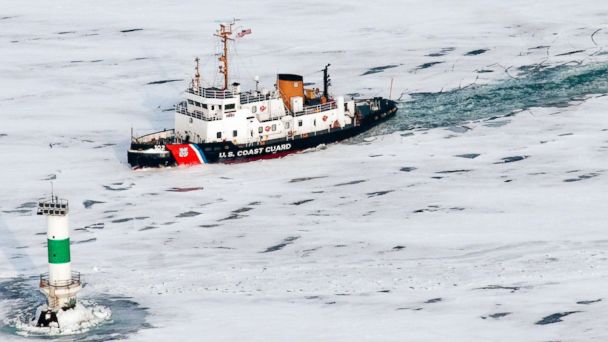US Coast Guard Battles Ice to Keep Shipping Channels Open
By JAKE WHITMAN and LAUREN EFFRON
In the midst of record-breaking bitter cold, the U.S. Coast Guard has been relentlessly fighting against ice build-up in the Great Lakes region in an effort to keep important shipping channels open.
A massive swath of arctic air known as a " Polar Vortex," plunged temperatures well below zero from Chicago to Tulsa. In those temperatures, ice can form up to a foot thick in the rivers that connect the Great Lakes.
The Coast Guard uses ice cutters, heavy ships that have thick, reinforced hulls and polar ice-breaking bows, to clear the major shipping route that separates the U.S. and Canada, so that freight-carrying ships can get through. Without the ice cutters, large freighters can get stuck.
The ice cutters cut tracks throughout the channels, up and down the St. Mary's River and through the Soo Locks. For those officers who work on the ice cutter boats, the job is far from easy.
"Some days, if you get strong wind, it will blow the track that you spent so much time building, say all day long, and it'll blow it out of the channel," said Lt. Commander John Henry on the Coast Guard cutter Bristol Bay. "Those days, those days are difficult."

The USCGC Bristol Bay, a 140-foot ice-breaking tug, cuts through ice in the Saginaw Bay shipping channel, Dec. 19, 2013. Credit: Yfat Yossifor/MLive/Landov
The Bristol Bay is one of four ice cutters that have been working around the clock to keep the shipping lanes open for freighters that use the Great Lakes and connecting channels to deliver goods between the Midwest and the East Coast. These massive ships range in length from 730 feet to over 1,000 feet - a ship that is 730 feet long can carry 37,000 tons.
"The biggest cargo for these lakers: iron ore, coal, heating oil and grain," Henry said. "They pretty much come and service all the Great Lakes, coming through the Soo Locks and then heading either to Lake Erie or Lake Michigan."
The Coast Guard said it was the earliest the ice had frozen here since the 1930s, and the river connecting Lakes Superior and Huron has been some of the toughest ice they have seen. With cutting through ice, the noise is loud and constant.
"Anytime you hit any type of ice, sound magnifies, especially when you're going through some pretty thick stuff," Henry said. "It's like a constant explosion, especially when you do this all day long from sun up to sun down. But you get used to it. That's the beauty of ice breaking. … We're out here because we want to be."